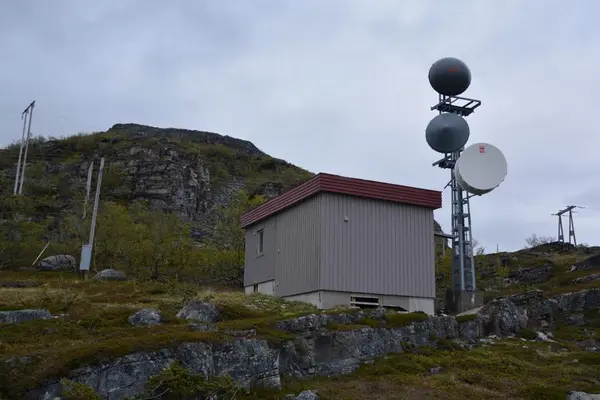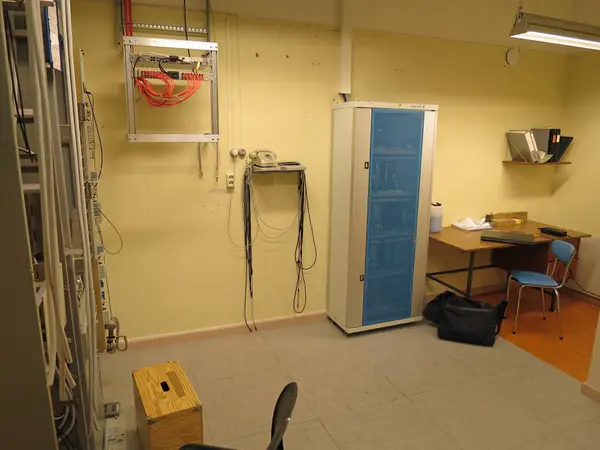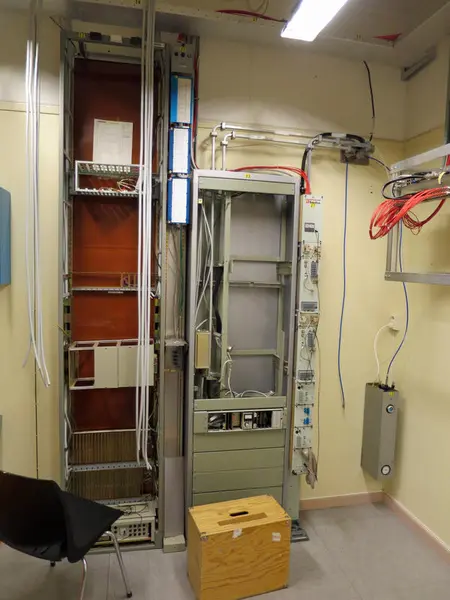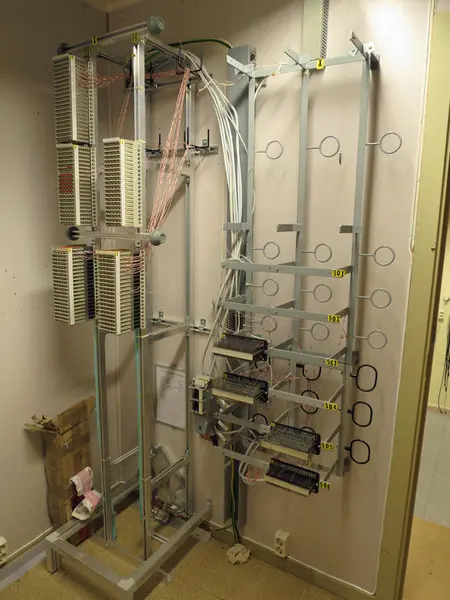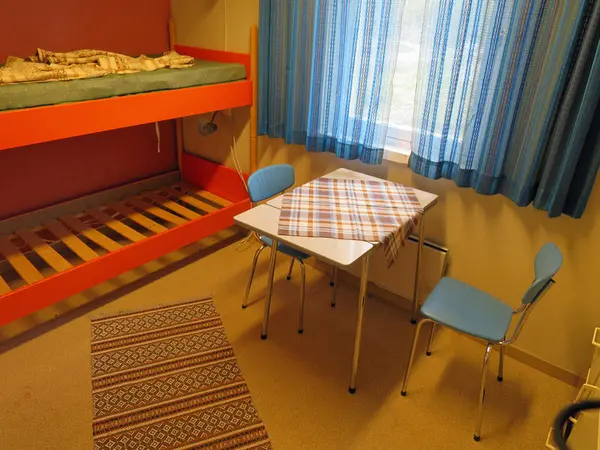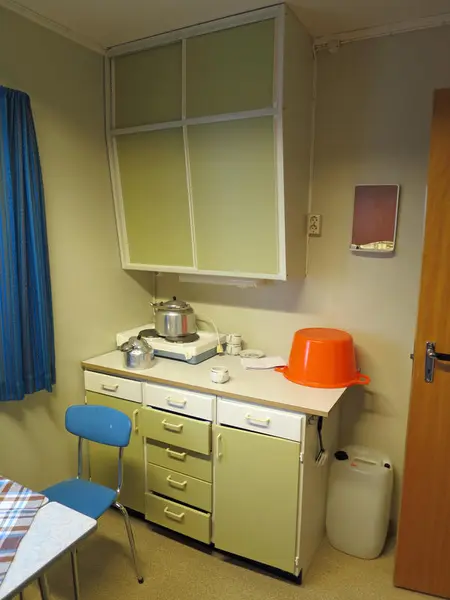- 1/1
Litlefjord automatic exchange Stein Domaas/Telemuseet
- 1/3
Interior, 2015 Terje Norli/Telemuseet - 2/3
Part of Litlefjord excange, 2015 Terje Norli/Telemuseet - 3/3
Technical installations, 2015 Terje Norli/Telemuseet
Imagine that you are a tele-technician in Hammerfest at the end of the 1970s. Imagine that you’re called out on an assignment. The automatic exchange that needs repairing is 105 kilometres away in a small fishing village, and the only way to reach it, is by boat. Imagine that the job takes longer than you thought, or that a storm blew up so that the last local boat was cancelled. You will have to spend the night.
This is how a day’s work could be for Rolf Mathisen, a veteran at Telenor and one of the automation technicians in Northern-Norway of those days.
-In the old days there were around 20 automation technicians based in and around Finnmark, he says.
-We were to be found in Kirkenes, Vardø, Vadsø, Mehamn, Lakselv, Hammerfest and Alta. The technicians worked as normal in the towns, but in addition we had to service all the small places in between. Bearing in mind that the expanse of Finnmark is equal in size to that of Denmark, and in villages and fishing communities automatic telephone exchanges had been installed. In those days the road network was lacking, and we were plagued by a lot of bad weather up here in the north. When sent on an assignment, a technician could expect to have to travel 100-150 km by car before getting on various local boats and ferries. Often, the job at the exchange would take a good while, and if we didn’t get on the last boat back that day, we’d have to spend the night. There was only one question though, where?
Rolf remembers with horror an automatic exchange in Kårhamn outside Hammerfest, where he was on assignment several times:
-The exchange was up on the third floor in a large fishery building. This wooden house was cold and not in very good shape, and up in the attic there was a pitched ceiling and only one window. There was a leather sofa up there, with a mattress where you could sleep. Under this sofa were the batteries for the exchange. If the wrong gas had started developing inside the main batteries you’d get the potential of an explosion. So you’d be sleeping on top of a bomb. If that had gone boom, I would have been dead 30 years ago.
This was no way to carry on. Luckily, the tele-technicians’ union in Western-Finnmark consisted of what Rolf Mathisen calls “very capable lads.” After some ardent union work, Telenor (Televerket) agreed to build some automatic exchanges adapted to the unusual working conditions. In addition to the room containing the technical equipment (automatic telephone exchange and transmission/radio receiver), we also got a room with two bunkbeds and an eating area, and even a chemical toilet.
Three generations of automatic exchanges
It didn’t happen overnight, says Mathisen, but in time Telenor (Televerket) installed 6 of these residential exchanges around West-Finnmark. They worked so well that the type soon spread to the eastern side of the county. In Telenor’s protection plan from 1997, however, it is Litlefjord that have been chosen to represent this North-Norwegian variety of a live-in telephone exchange:
-Litlefjord is quite special, says Mathisen.
-How’s that?
There are three generations of technical equipment in this exchange.
The Litlefjord exchange was built as an exchange for something called the FS-20, which meant you could connect 20 subscriptions from here. Life in Televerket didn’t stop, however, and technology changed. The next generation of automatic exchange was too big for the housing; it was too low under the ceiling. As the Litlefjord exchange was situated in a hillside, it wasn’t too much of a challenge to enlarge it, and that’s what happened in 1976. The room was extended and the roof lifted to make room for the ARK511, a more modern exchange. The old exchange was taken down and ARK511 was in service for a while, until yet another exchange appeared, this time a digital type. A digital exchange is small enough to be put into a suitcase and stored in a corner, he says.
-So in this particular automatic exchange, there are actually three generations of equipment.
-
Overnight accommodations at Litlefjord exchange Terje Norli/Telemuseet
That cabin feeling
Did you ever work in Litlefjord automatic exchange yourself?
-Oh yes. I spent the night there.
-And how was that?
- We lived really well, says Rolf, smiling.
In the beginning, there was no road out to the exchange. You’d arrive by local boat, and you would have to leave by local boat. You would have to bring food in your back-pack and an extra stump of bread in case the boat was unable to land due to bad weather. The little kiosk was so well insulated, however, it was just like entering a cabin. It was that nice in there. I could leave Hammerfest in snow and rain, and when I entered “the cabin” it was snug and warm. There I could sit and look at the life on the sea, or in the fishing community.
Rolf is nodding, it was a great job. The technicians in Telenor (Televerket) loved their work, but the world goes on, and things change, both in Telenor and for small fishing communities in Finnmark.
-The background for placing an automatic exchange in Litlefjord, was that it was a nice little village between Hammerfest and Havøysund. In those days you couldn’t really drive much further than Litlefjord. When the road to Havøysund opened, it had big consequences, tells Rolf.
-Instead of shopping at the local fish market in Litlefjord, people jumped in their cars and drove to bigger places. The local shop was also struggling. The shop went bankrupt and so did the fish monger. He was a man who ran his business really well. I remember that it was always so cosy in his premises. Today, everything has fallen apart. The pier where the fishing boat would land has decayed. There is just a pile of rotten wood left now.
-It’s sad when such local communities disappear?
-Yes, but such things are happening all over Norway, he says.
-But the exchange remains. The exterior mast is still there, and the technical equipment is still in use by Telenor.
-
Kithen facilitis at Litlefjord Terje Norli/Telemuseet
It’s no more than a year ago since Rolf was last at the automatic exchange in Litlefjord, on an inspection for Telenor Cultural Heritage. The retiree has had the responsibility for the Norwegian Telecom Museum department Finnmark, since the museum was started, and he knows every mast and line in his home county. He laughs quietly:
-I started in Televerket in 1953. After one year down in Asker (Southern Norway,) I thought to myself; “Ten wild horses cannot keep me in Oslo.” I wanted to go home.
Recently, the 82 year old has been told that the museum will close down. So what is he planning to do with his time now?
-I have reached a stage in life where I can say with a clear conscience that now I’ll be slowing down, smiles Rolf Mathisen.
- I’ll be spending more time in my cabin.
